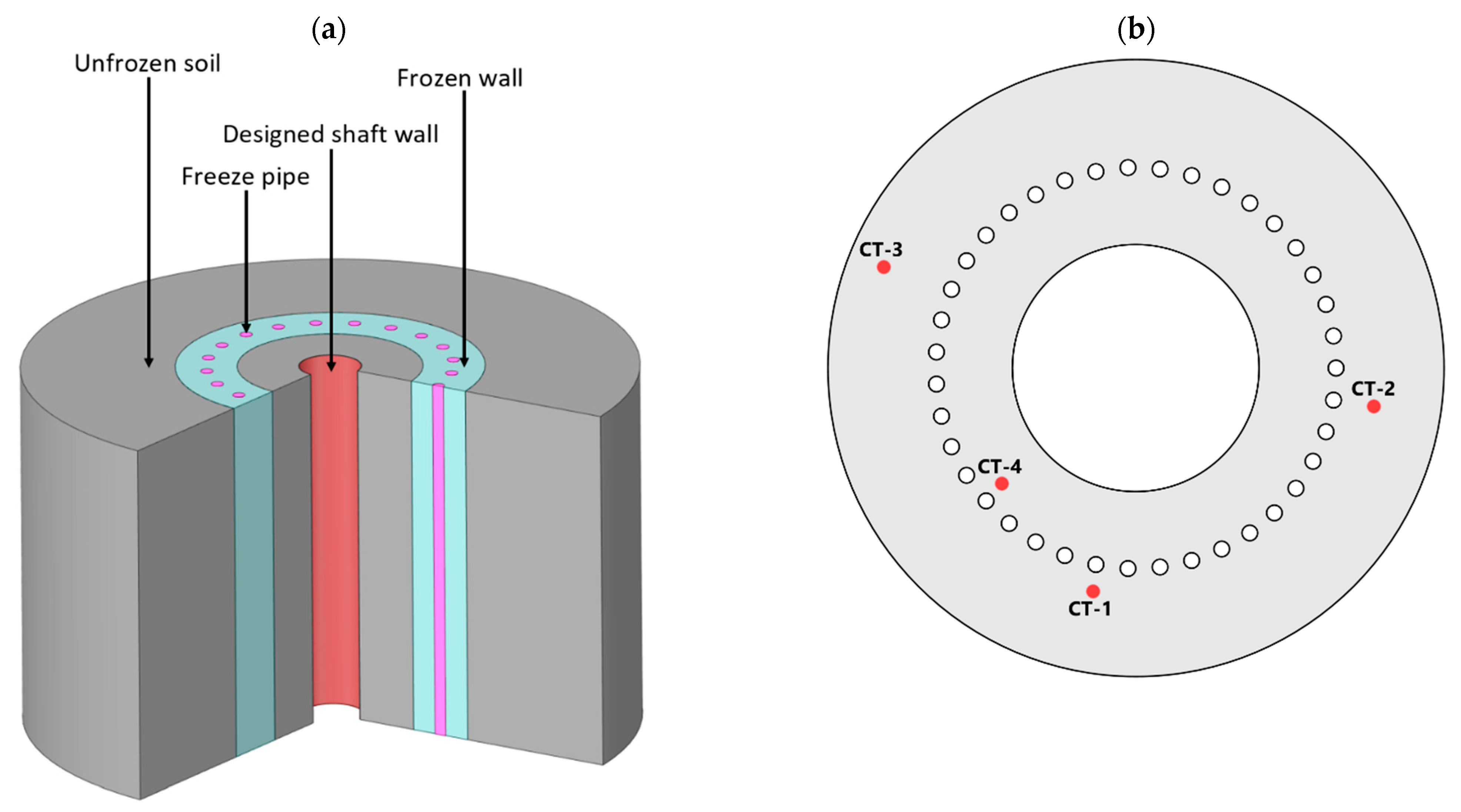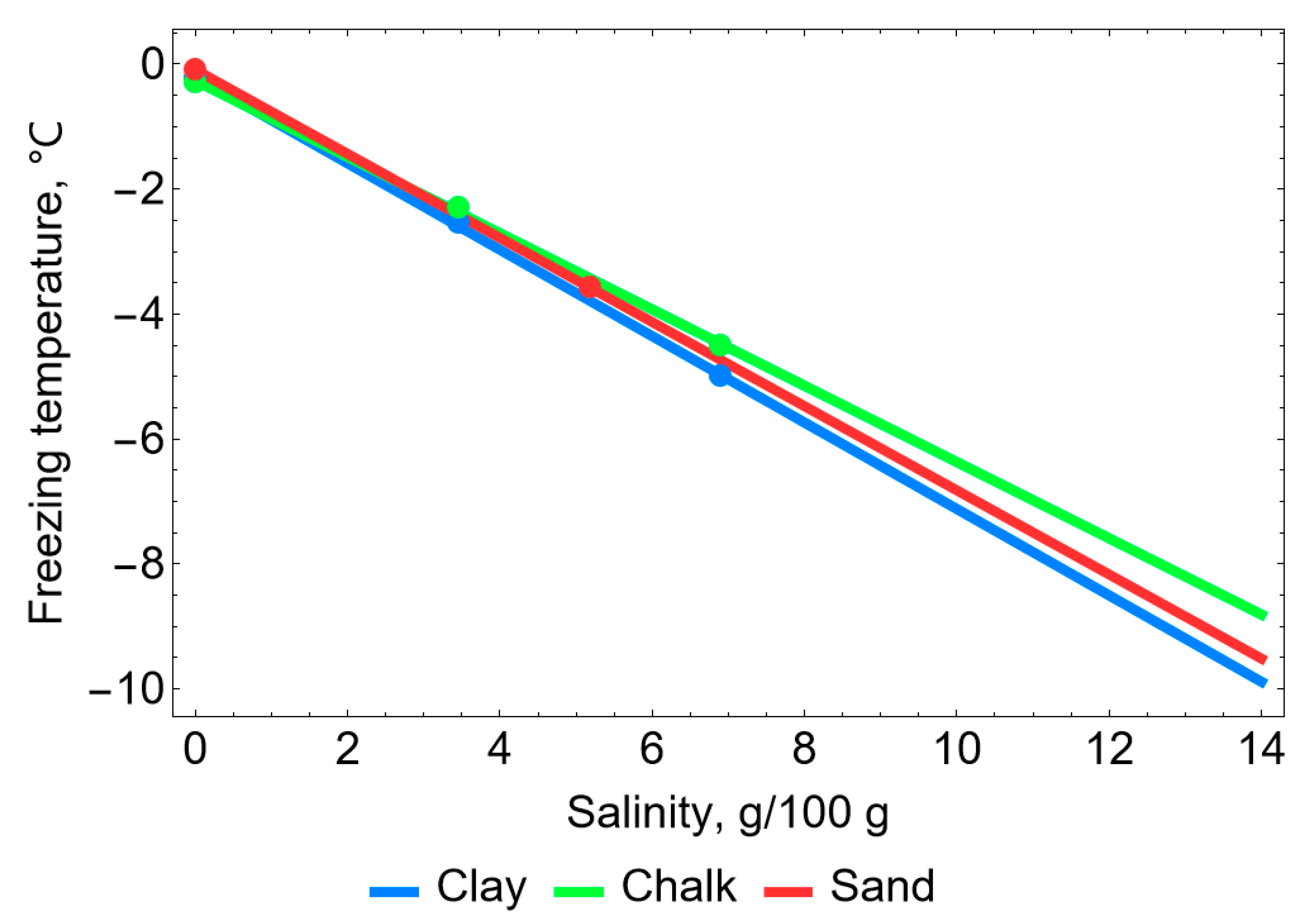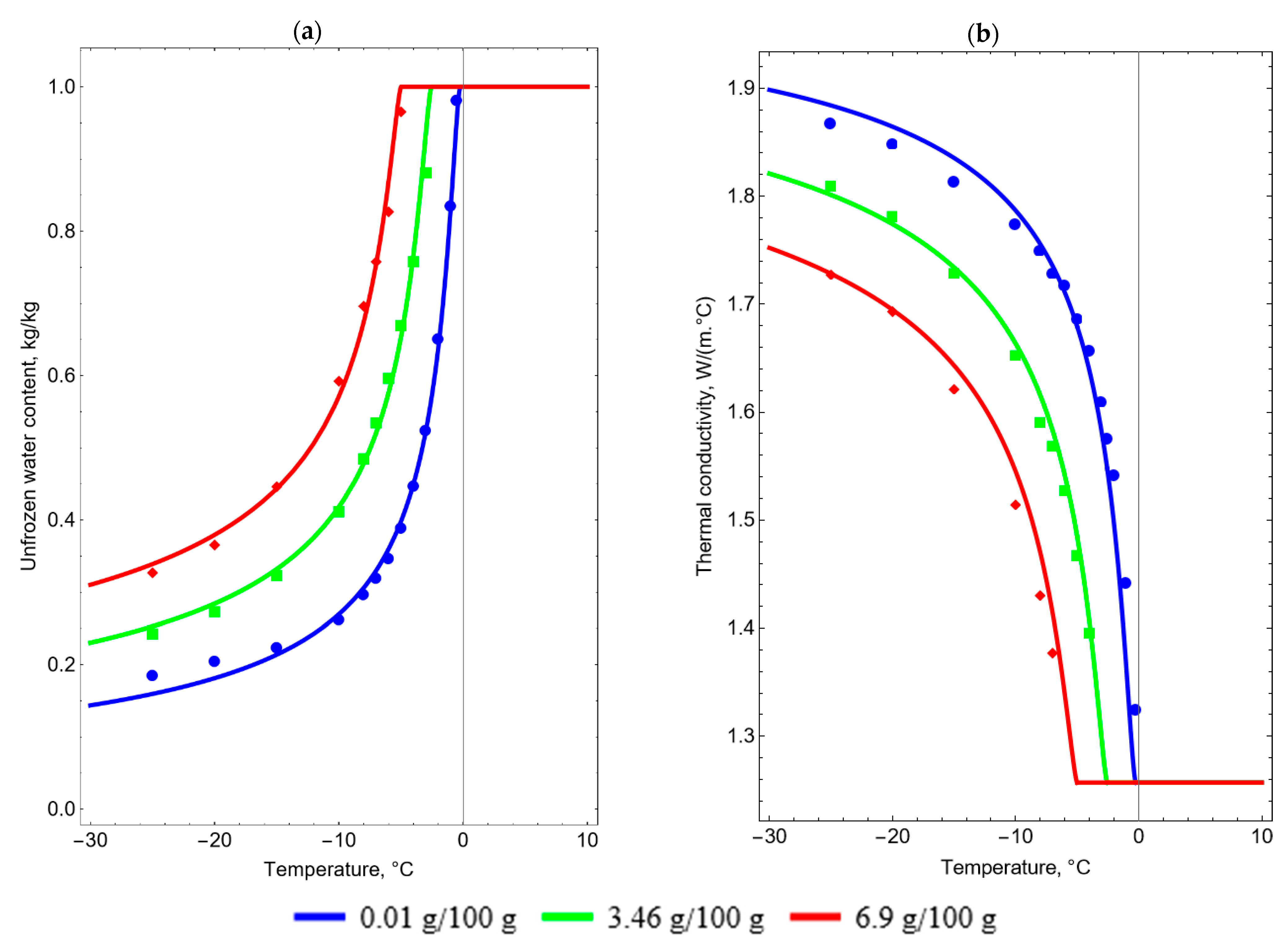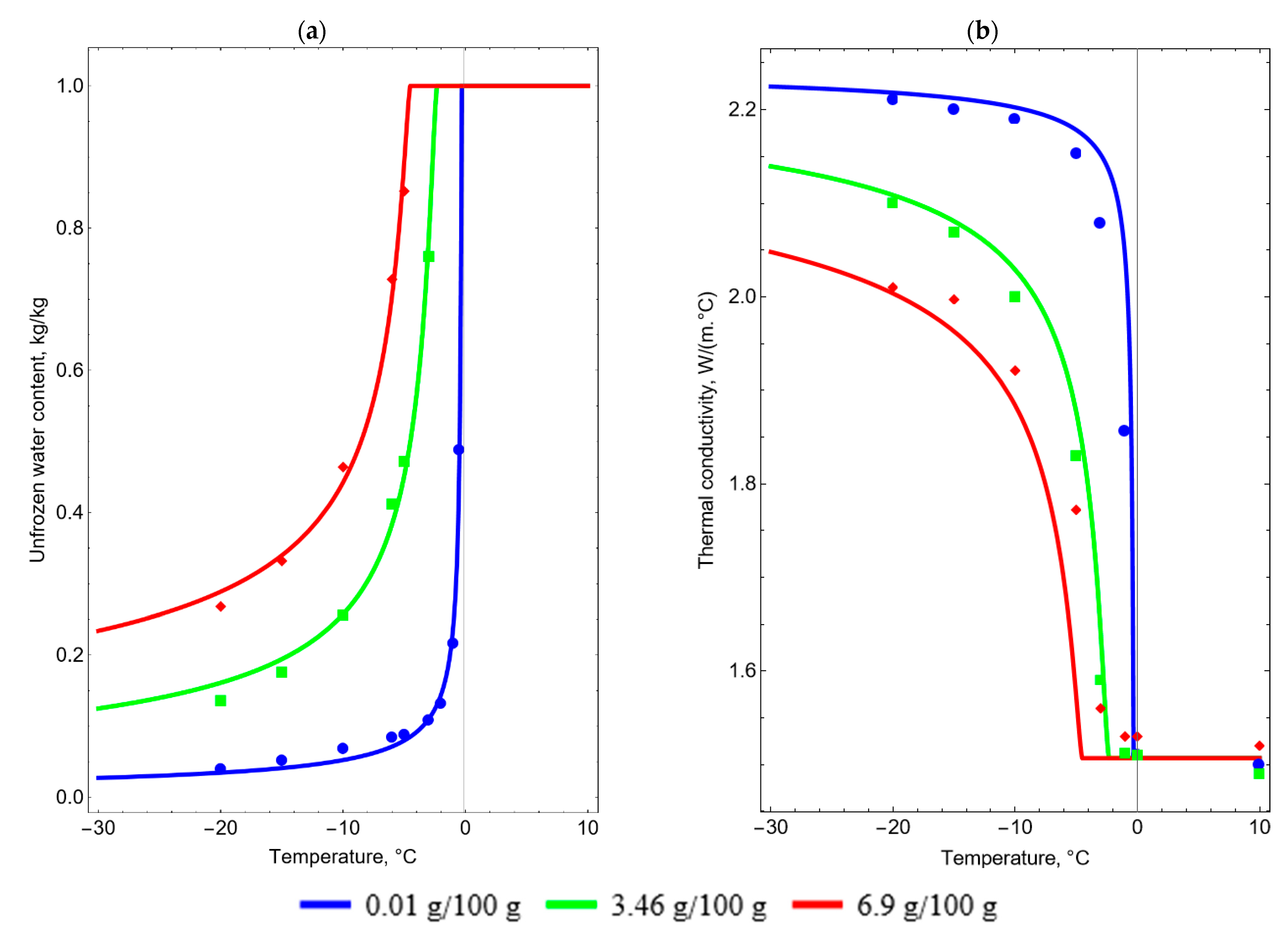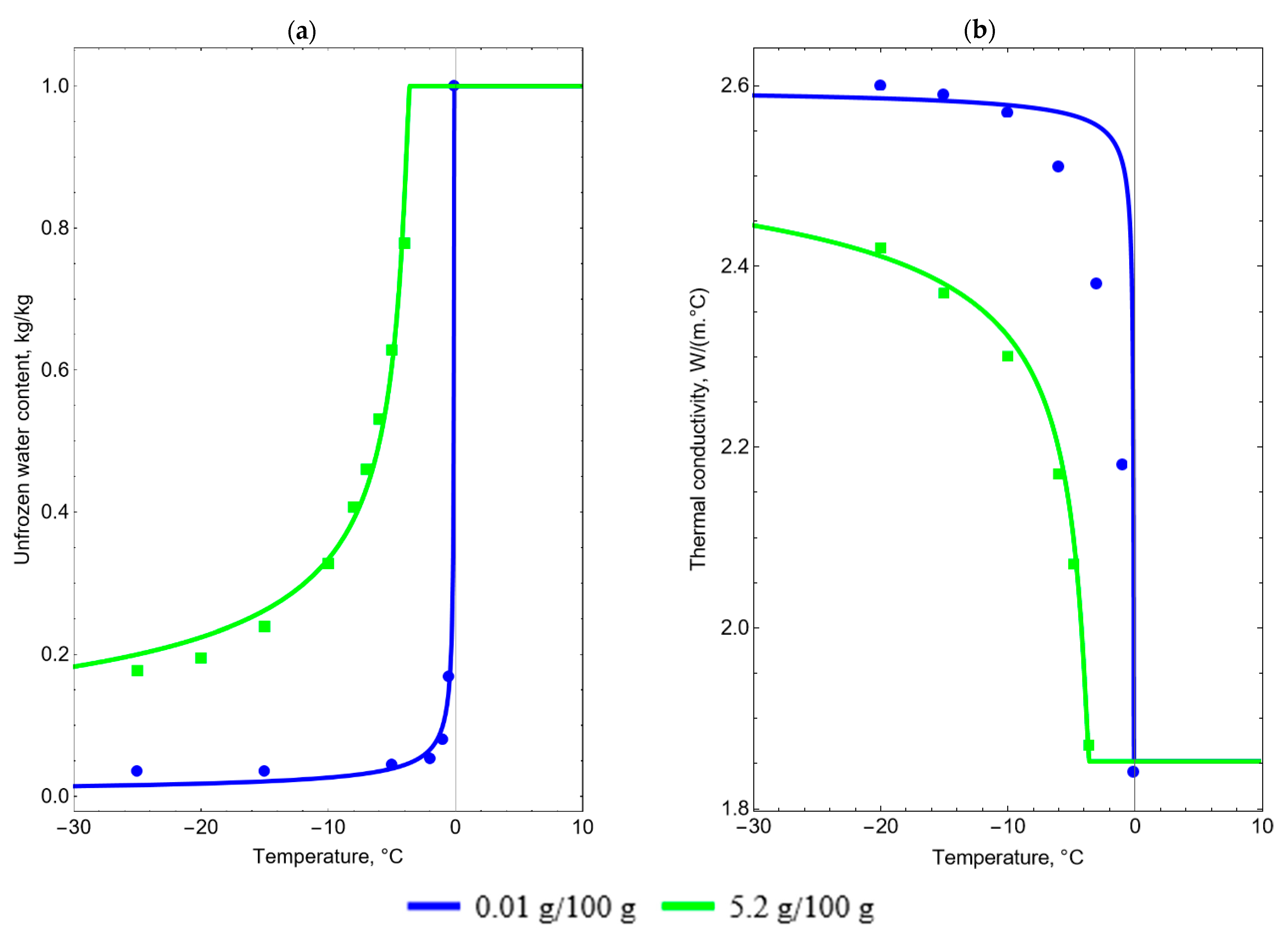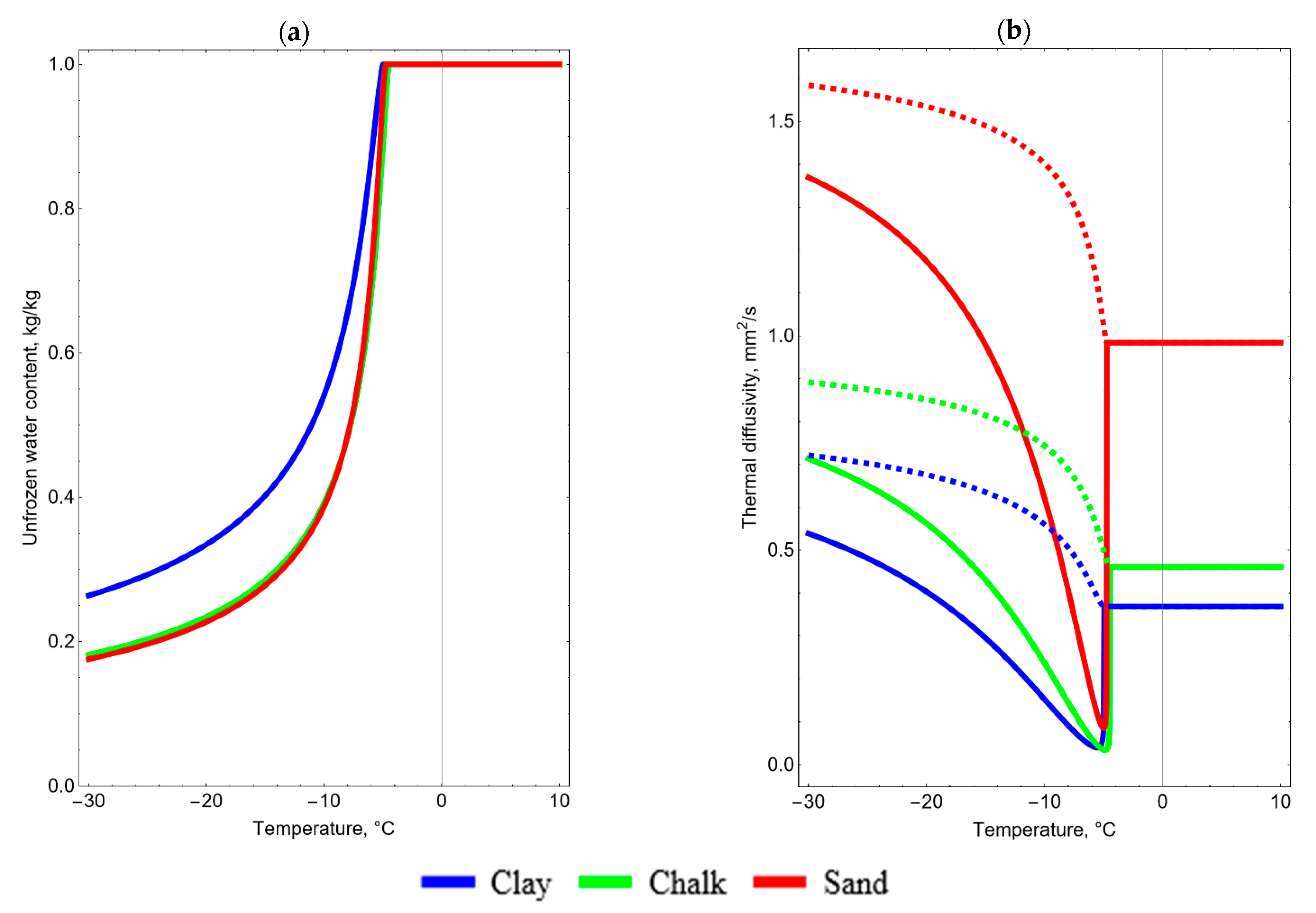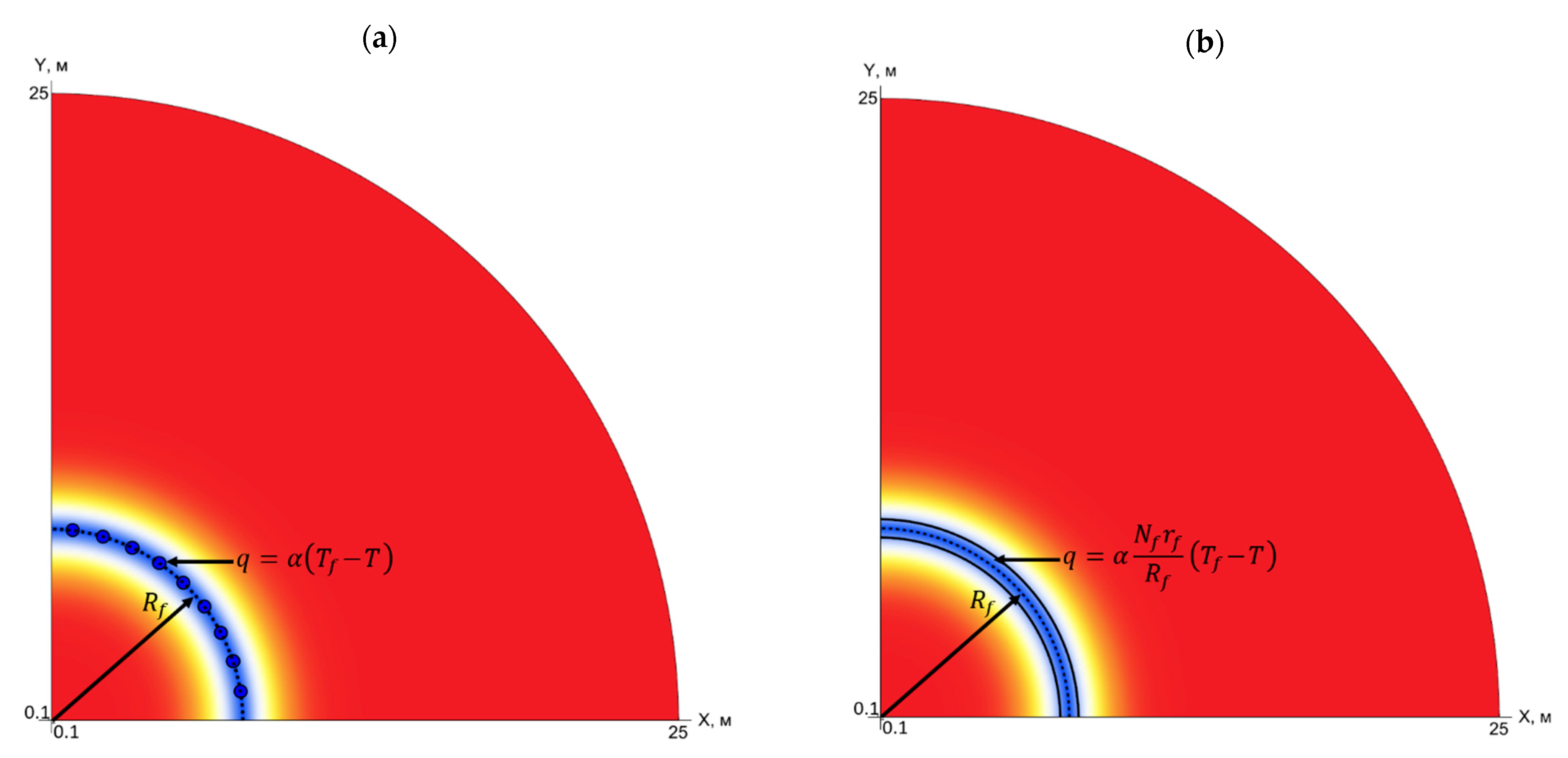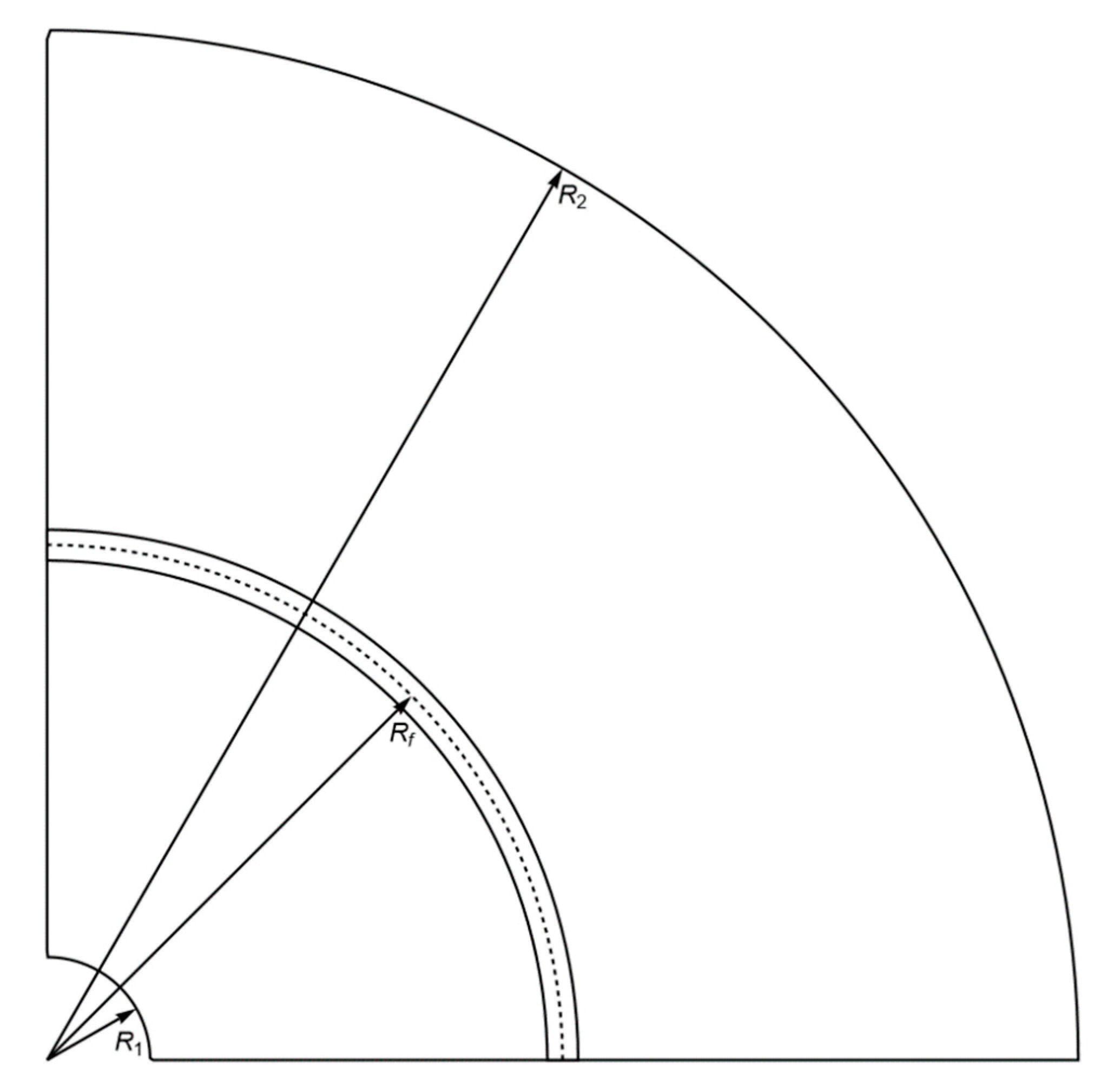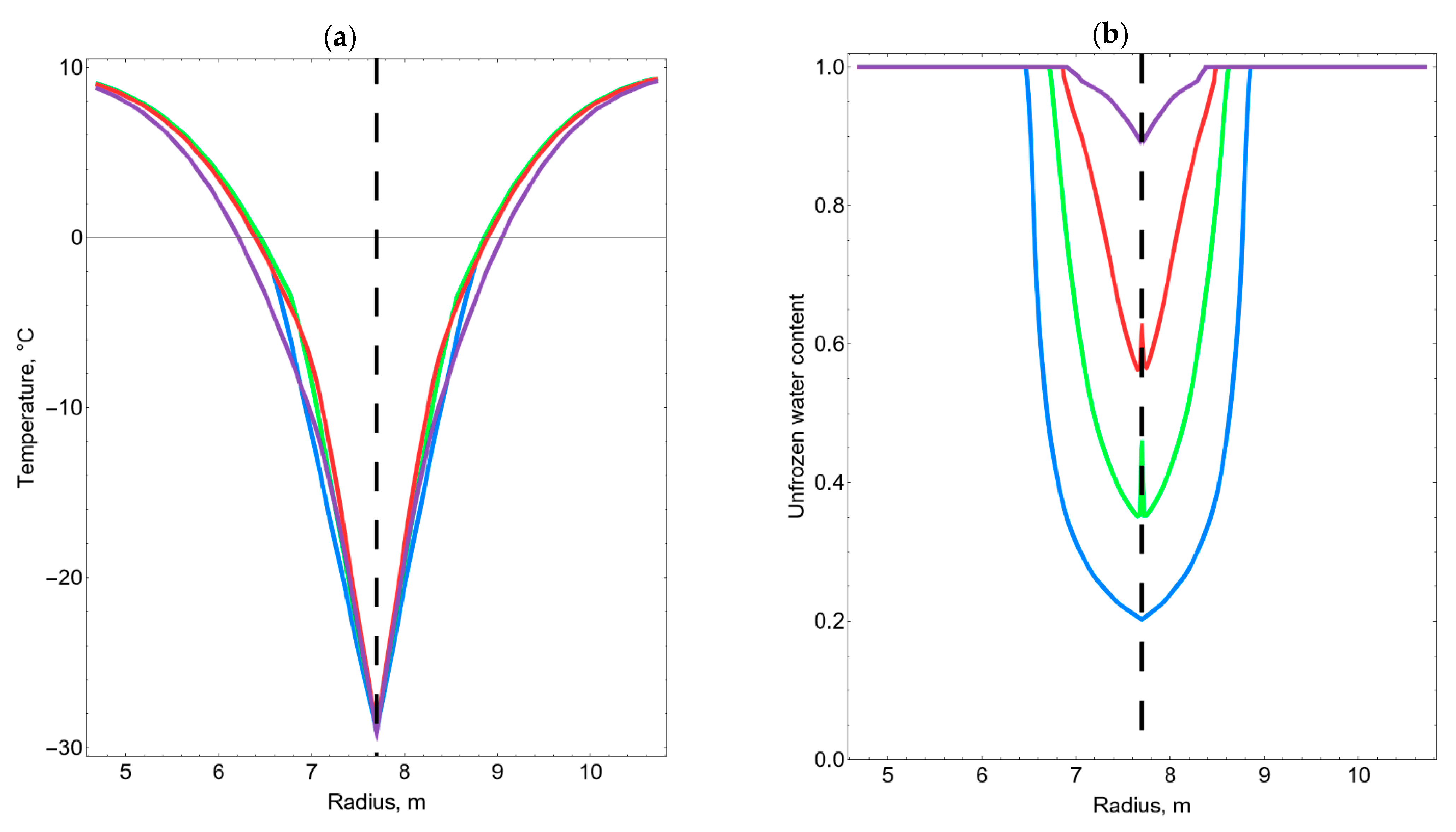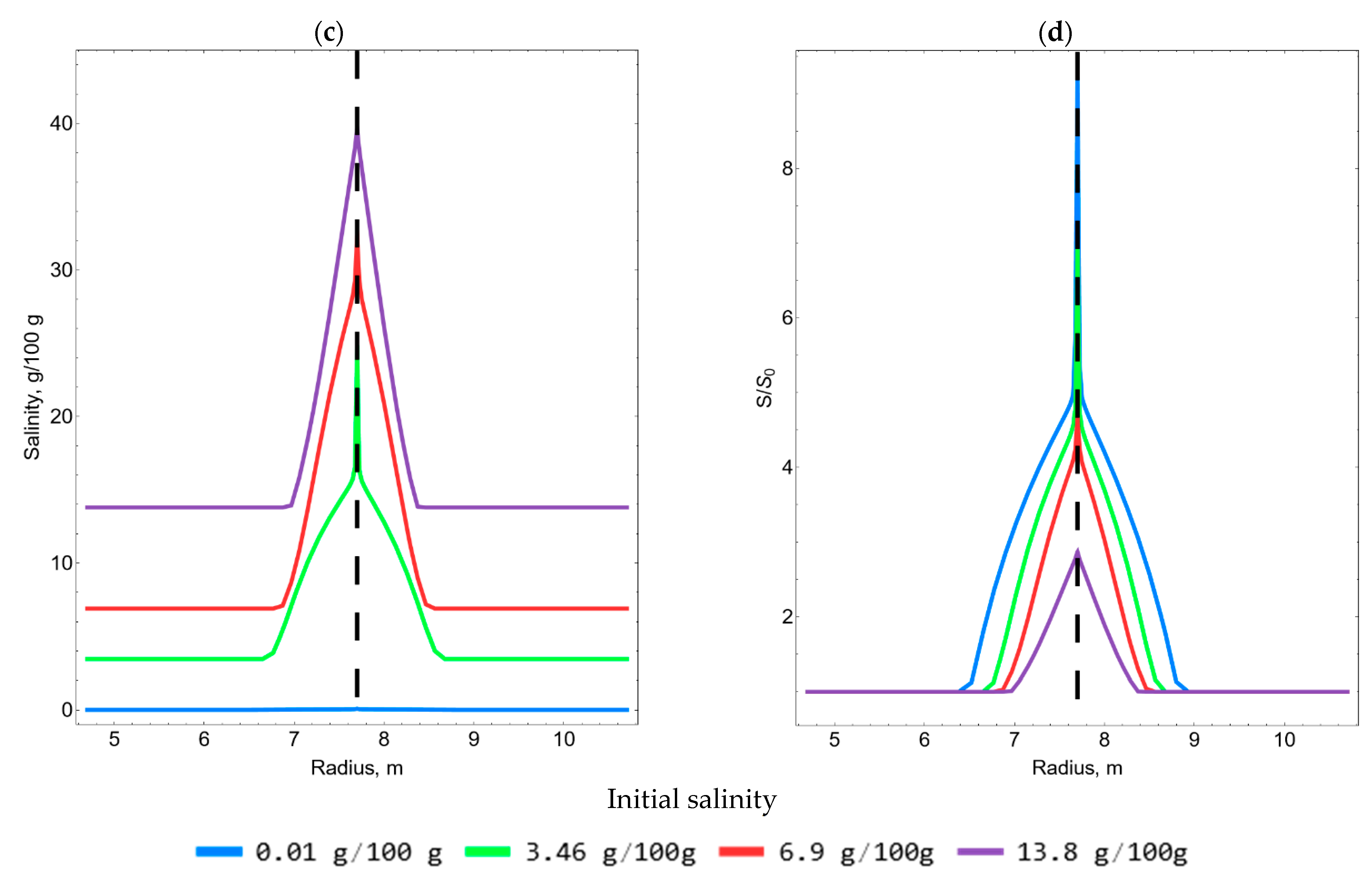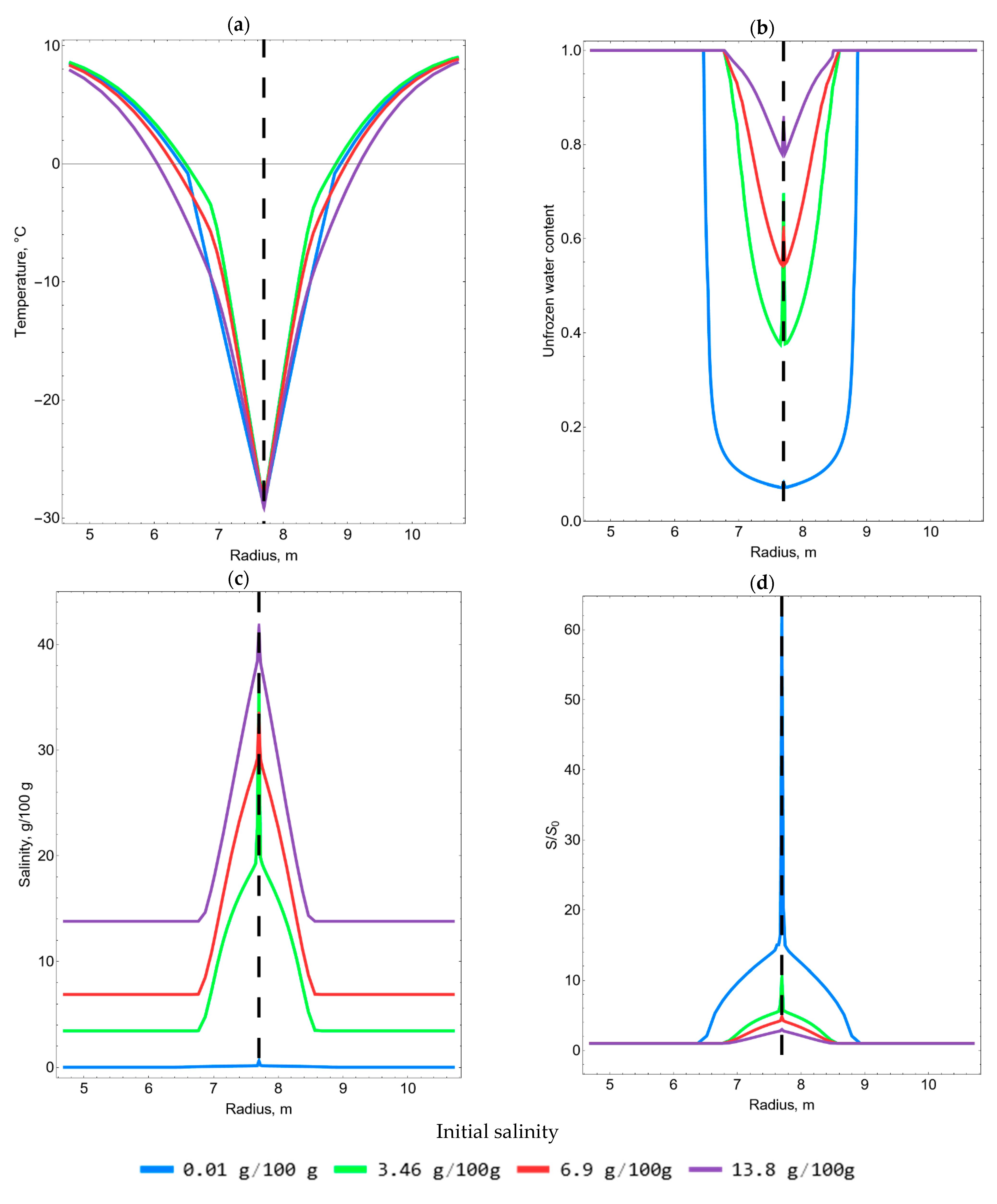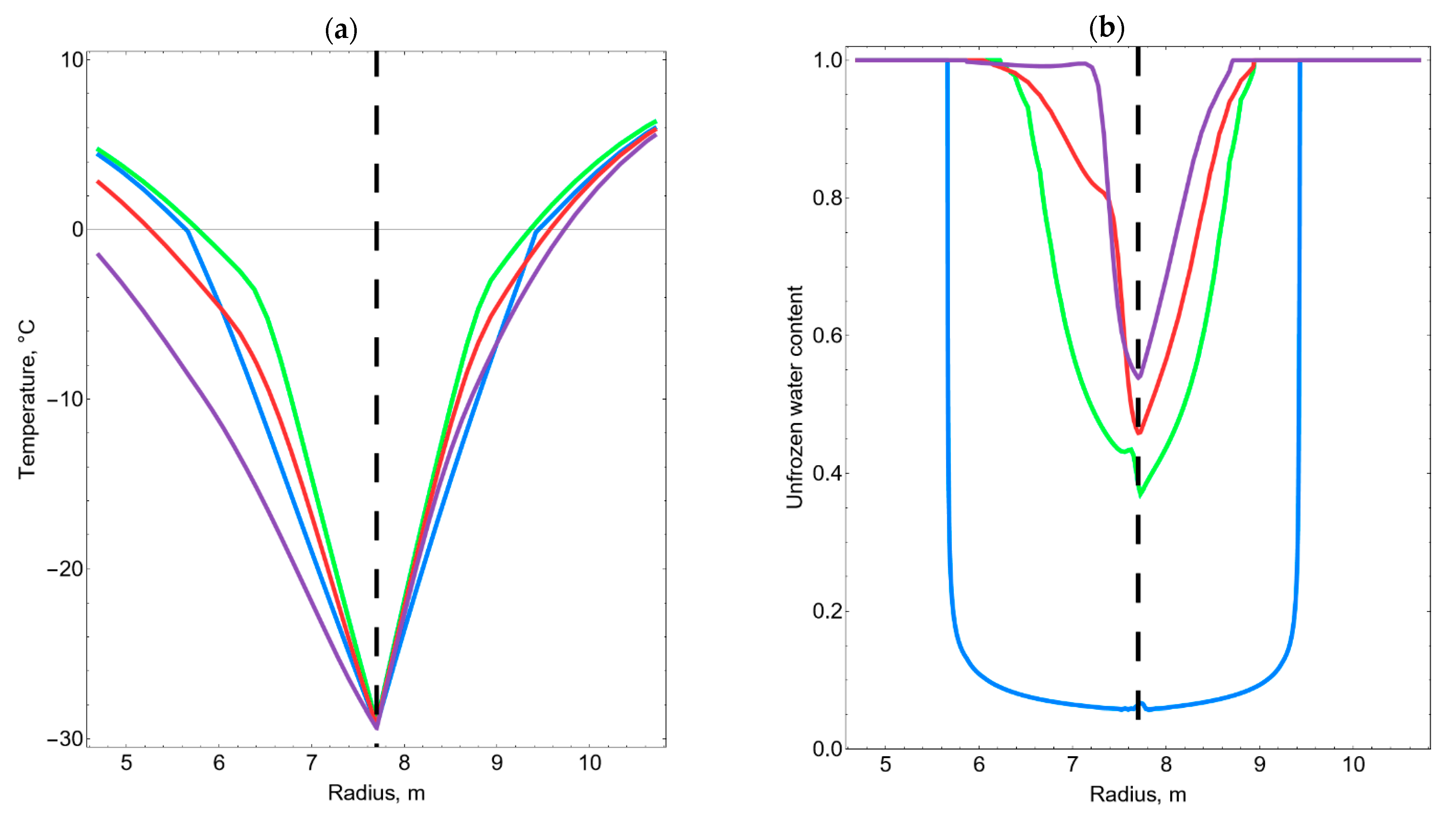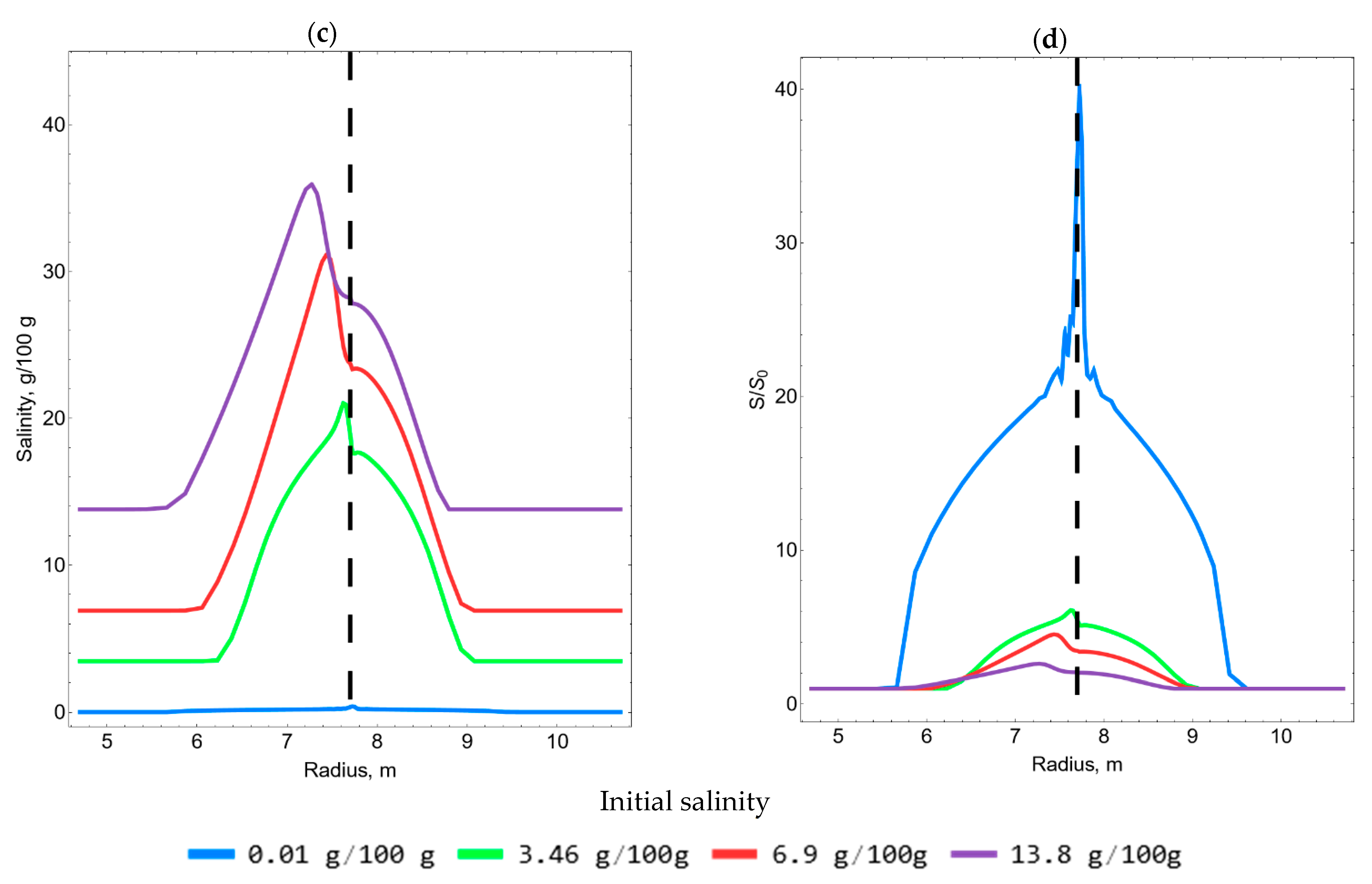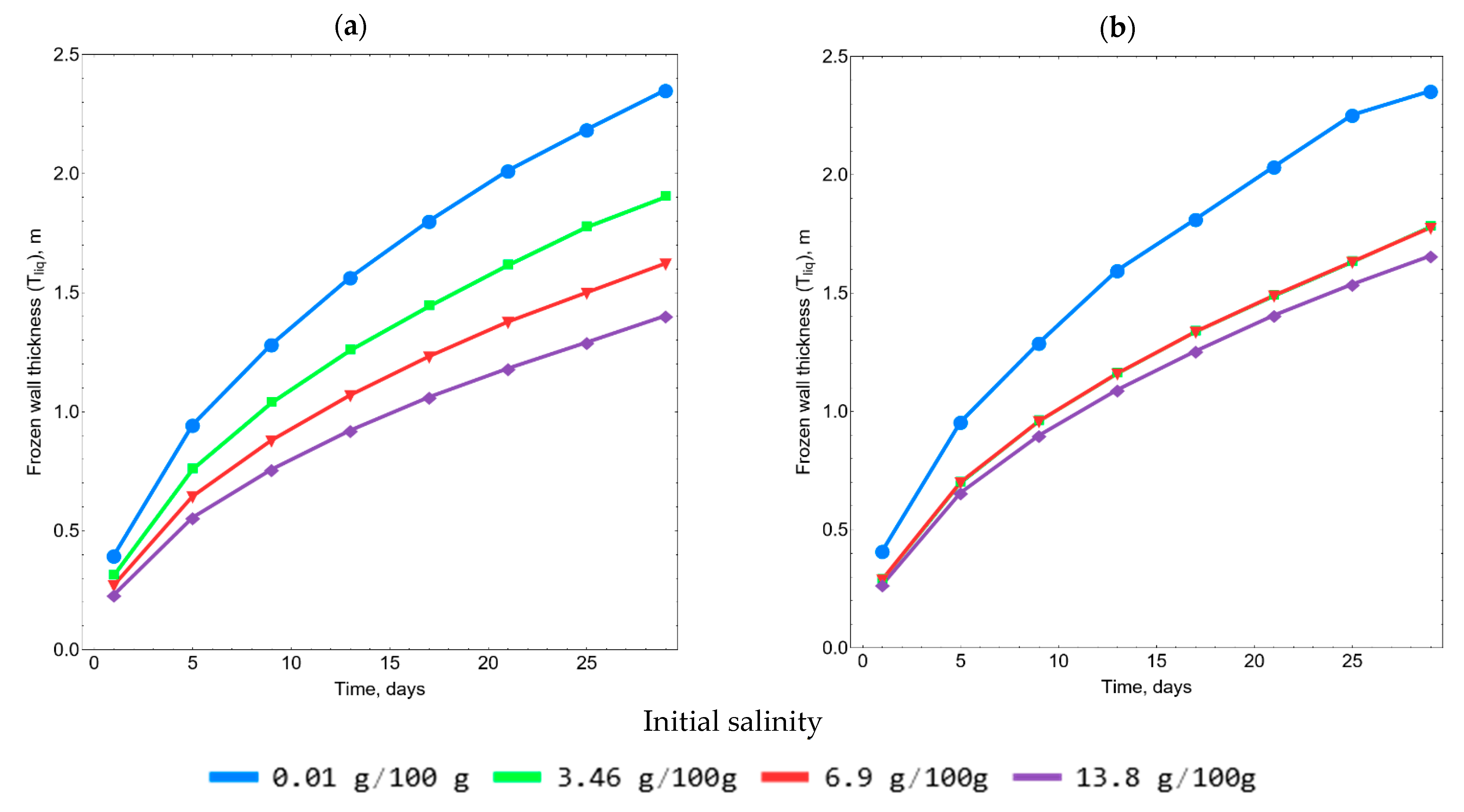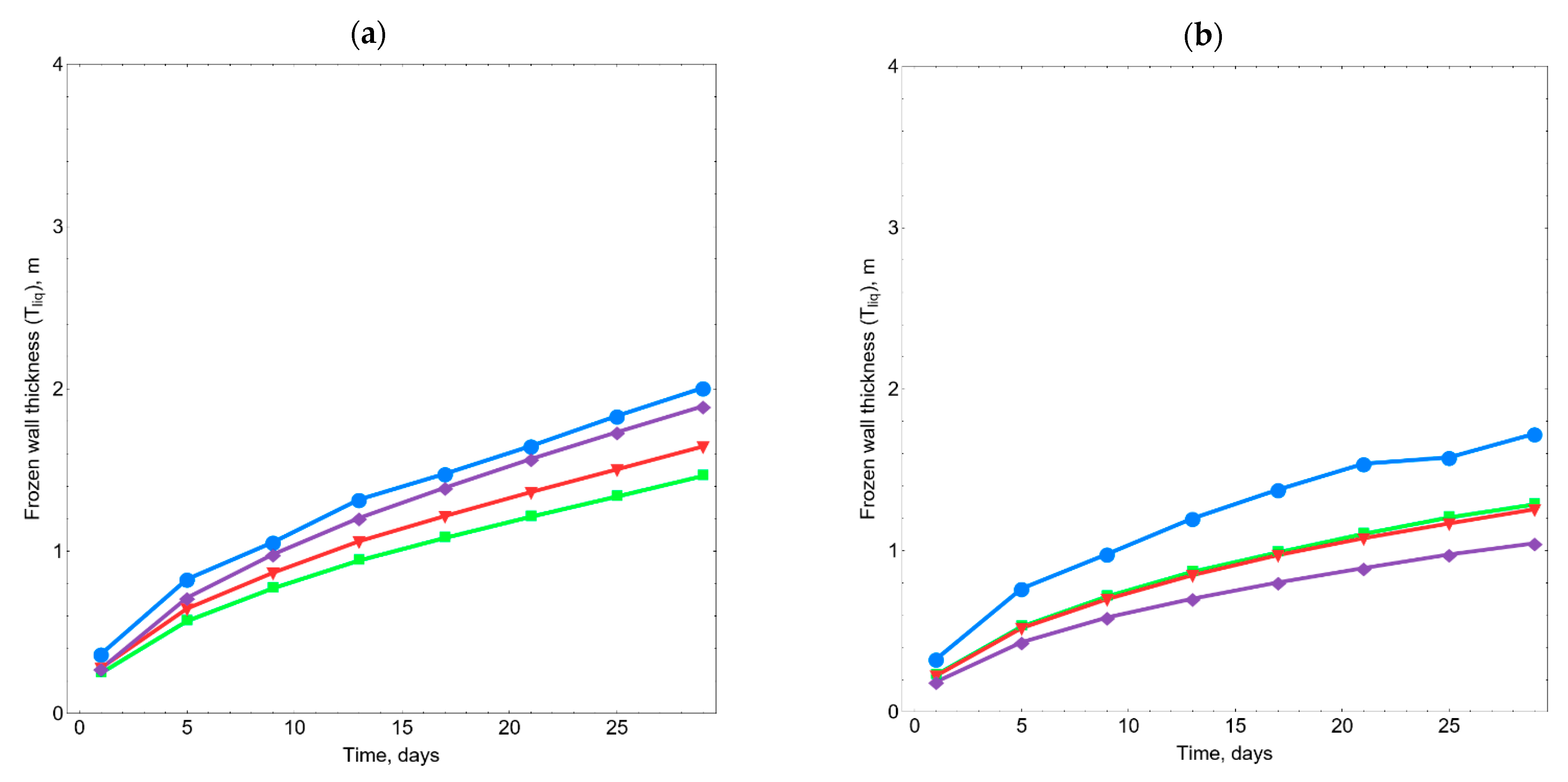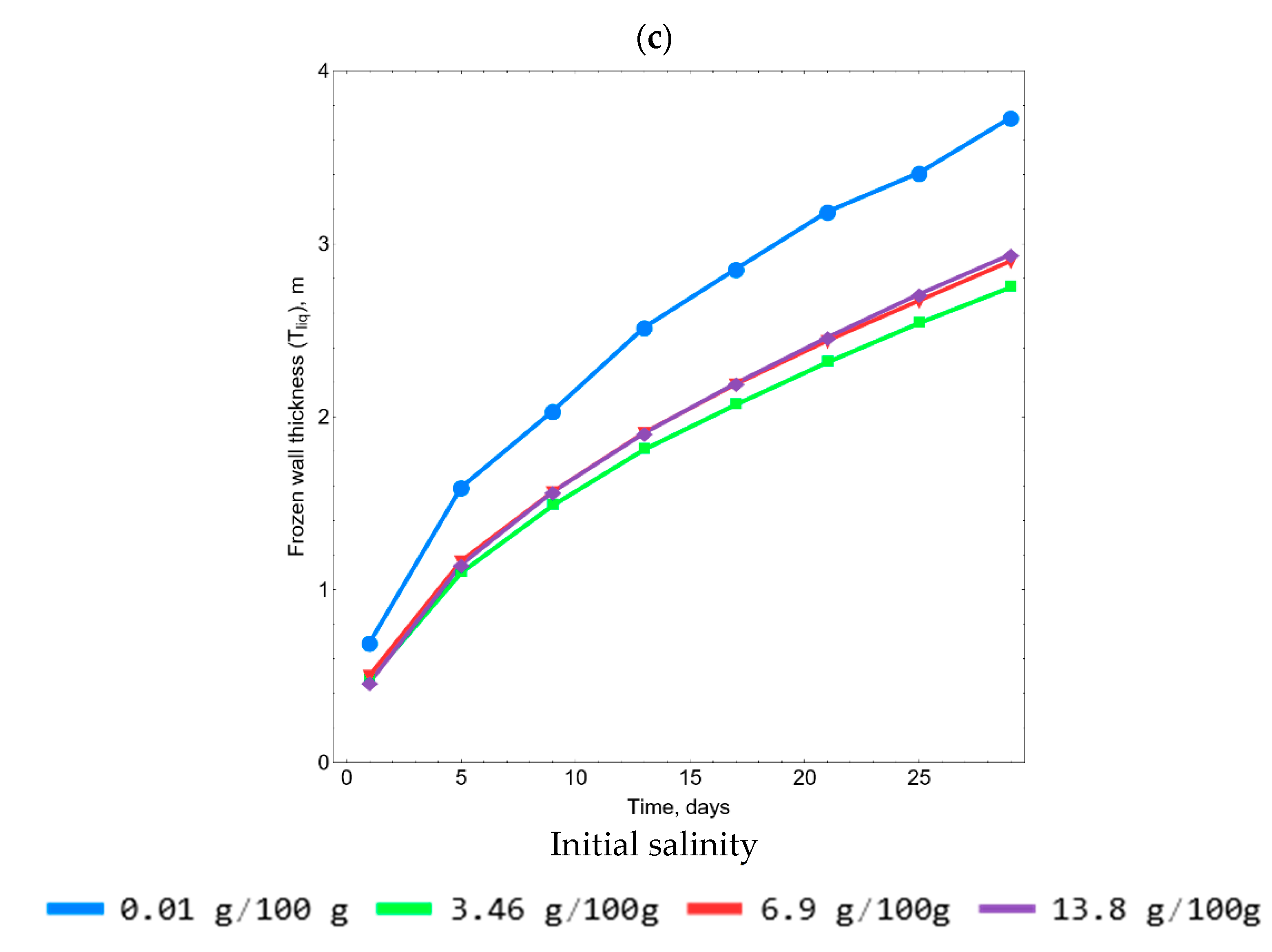2.1. Sample Preparation
Here, we describe the experimental studies that were implemented to identify the dependence of the thermophysical properties of soils on negative temperatures and levels of salt concentration in porewater. They are important for the subsequent analysis of the characteristic features of the effects of salinity on heat transfer in soils during freezing. Porewater containing a solution of NaCl salt was considered. Argillite-like clay, chalk, and sand were studied. The choices of the soils and salt types were based on the fact that they are the most common for the above-salt strata of potash salt deposits.
This study was conducted according to a well-known technique [
26].
To elucidate the patterns of salt influence on the phase composition of water and the thermophysical characteristics of soils, the samples’ initial compositions needed to be as identical as possible. Consequently, investigations were carried out on samples with a compromised structure (pastes) at a water content and density that matched those of samples with a natural composition.
To achieve this, the chosen material was initially crushed using a laboratory mill and then sieved through a mesh with a diameter of 5 mm. Subsequently, it was meticulously mixed, placed within a sealed container, and left to age for a full calendar week. Preliminary experiments indicated that this duration was adequate for ensuring a consistent distribution of moisture throughout the sample’s volume. Only after this period was the material’s moisture content determined, which was regarded as its initial state.
Each type of soil was represented by nine samples. These samples were divided into three groups of three samples each. Each group of samples was associated with a certain soil water content. Additionally, the samples in each group were divided as follows: (1) samples with distilled water and the standard freezing temperature of the porewater; (2) samples with a NaCl content for which the freezing point of the porewater was 2 °C lower than the standard freezing temperature; (3) samples with a NaCl content for which the freezing temperature of the porewater was 4 °C lower than the standard freezing temperature. It is worth noting that, in the case of clay, studies were conducted for three values of initial water content. Chalk and sand studies were performed with only a single value for initial water content.
2.2. Methods of Measurement
All experiments were implemented in the Laboratory of Physicochemical Mechanics of Natural Dispersed Systems of the Institute of Nature Management of the National Academy of Sciences of Belarus. The unfrozen water content, the freezing temperature of the porewater, the specific heat capacity, and the thermal conductivity of the soil were the studied thermophysical parameters during the freezing process. A calorimeter was used to determine the unfrozen water content, the freezing temperature of the porewater, and the specific heat capacity. The principle underlying these measurements is the creation of adiabatic conditions, or conditions of controlled heat exchange, around a calorimetric cup filled with the sample under study. This allows for the determination of the thermophysical parameters under study (water content and specific heat capacity) at positive and negative temperatures, as well as the investigation of the changes in unfrozen water content during freezing and thawing cycles. The accuracy of the device is ±0.01 °C when measuring temperature, and the relative error in determining the heat of the phase transition is ±1%.
Experimentally measured masses of water and ice in the sample were used to calculate the unfrozen water content according to the following equation:
where
is the unfrozen water content,
is the mass of water in the sample (kg),
is the mass of ice in the sample (kg), and
is the mass of the dry skeleton of the soil (kg).
The specific heat capacity was calculated for the dry skeleton of the soil using the following equation:
where
is the specific heat capacity of the dry skeleton (J/(kg·°C));
is the measured effective specific heat capacity of the soil sample (taking into account the phase transition of the moisture) (J/(kg·°C));
and
are the specific heat capacities of water and ice (J/(kg·°C)), respectively;
is the heat capacity of an empty calorimeter (J/°C);
is the initial soil moisture (kg/kg);
L is the specific heat of the phase transition of the moisture (J/kg);
is the amount of heat required to supply the calorimeter so that its temperature changes by
(J); and
is the total mass of wet material (skeleton + water + ice) (kg).
The thermal conductivity of the soils was determined using a unique device based on the method of the stationary thermal state of the soil samples. The device features the use of original heat flow sensors mounted in metal heat-exchanger housings. This makes it possible to average the temperature field in the measurement planes and to protect the heat flow and temperature sensors from mechanical, physical, and chemical damage. The relative error in determining the thermal conductivity is 6%.
The calculation of the thermal conductivity coefficient was conducted in the stationary thermal state of the test sample according to the readings of the signals of the heat flow sensors with two heat exchangers. The first one is located on top of the sample, while the second one is located below it. Before the direct calculation of the thermal conductivity of the samples, the calibration parameters were determined based on the reference sample according to the following equations:
where
is the ratio of the heat fluxes of the upper and lower heat exchangers;
and
are the heat flows of the lower and upper heat exchangers in steady thermal mode, respectively (W/m
2);
is the thermal conductivity of the reference sample (W/(m·°C));
is the temperature difference of the heat exchangers (°C); and
is the sample height (m).
As a result, the thermal conductivity of the soil samples is determined using the following equation:
2.3. Results and Processing of Experimental Measurements
Table 1 shows the measured density of the wet soils and the specific heat capacity of the dry skeleton.
Table 2 shows the dependence of the freezing temperature of the porewater with different levels of NaCl content in units of g/100 g of moisture. (Hereafter, “NaCl content” is replaced with “salinity”.) In
Table 1 and
Table 2, clay parameters are presented only for one value of water content: 0.26 kg/kg. These parameters appear to be the most interesting from the point of view of comparative analysis with the thermophysical properties of chalk, which has nearly the same water content: 0.25 kg/kg. The results of the experimental measurements of clay parameters with other water content values can be found in [
7].
The obtained experimental dependencies for the freezing temperatures of the porewater were approximated by a linear dependence (see
Figure 2). It should be noted that, in general, the freezing temperature of water may depend nonlinearly on salinity [
27]. However, subsequently, the numerical simulation of the heat and mass transfer in the saline soils was implemented with salinity values in the range of 0.01 g/100 g to 13.8 g/100 g. For this range, the error of the linear approximation relative to the nonlinear one, according to the data from [
27], was about 0.2 °C, which can be considered insignificant.
Table 3 shows the results of the experimental measurements of the dependence of the unfrozen water content on temperature and salinity, and
Table 4 shows the results for the measurements of thermal conductivity.
The functional dependence of the unfrozen water on temperature and salinity is given by a well-known empirical dependence [
28,
29]:
where
is the unfrozen water content (kg/kg),
is the freezing temperature of porewater (°C),
is the temperature (°C),
is the characteristic cooling temperature associated with the most common pore radius (°C), and
is the index indicating the distribution of the pore radius relative to the average radius.
The unknown parameters of Function (7),
and
, were determined via experimental measurements using the least squares method. The obtained values for various types of soils and salinity are presented in
Table 5. Later, during the process of numerical simulation, the dependence of the value
on salinity, according to
Table 5, was approximated by a linear function, and the value of
was given as a constant due to its small change in the considered range of salinities. Its value is equal to the mean of m values for three soil samples with different salinities.
The functional dependence of the thermal conductivity was set by a known dependence on the unfrozen water content [
30]:
where
is the thermal conductivity of the soil (W/(m·°C)),
is the soil porosity, the “
s” index corresponds to the dry skeleton, the “
w” index corresponds to the water, and the “
i” index corresponds to ice.
The porosity of soils can be calculated using the following equation:
However, comparative analysis showed that it is not possible to achieve a good agreement with the experimental data when calculating the thermal conductivity according to Equation (8). It was assumed that the reasons for this are unaccounted for by physical factors. For example, these may include a change in the thermal conductivity of the solution due to a change in its salt concentration, the migration of moisture, or the limited applicability of Equation (8) for the types of soils under consideration. Another possible factor is the error (6%) in the experimental measurement of thermal conductivity, as noted earlier. In this regard, to calculate the coefficient of thermal conductivity, a correction factor,
, is introduced into Equation (8):
Table 6 shows the calculated porosity and thermal conductivity of the dry skeleton for the studied soils (index “
s” in Equation (10)) from the minimum mismatch with the experimental data on thermal conductivity. The mismatch was calculated as the root-mean-square error. It was assumed that the thermal conductivities of water and ice are 0.56/2.20 W/(m·°C), respectively.
Figure 3,
Figure 4 and
Figure 5 show the dependencies of Equations (7) and (8) for each type of soil, with superimposed experimental data in the form of markers.
Based on the measurements from
Table 1 and measurements processed according to the unfrozen water content and thermal conductivity, the specific heat capacity of the soils was set according to a known dependence [
30]:
where
is the soil density (kg/m
3), and
is the specific heat capacity of the soil at a constant pressure (J/(kg·°C)).
Figure 6 shows the obtained dependencies. It was assumed that the density of water/ice is 1000/912 kg/m
3 and the specific heat capacity of water/ice is 4200/2100 J/(kg·°C).
The comparison of thermophysical properties of soils in
Figure 3,
Figure 4,
Figure 5 and
Figure 6 enabled us to observe the following similarities and differences among them:
As the salt concentration increases, all the considered soils exhibit an increase in the amount of unfrozen water, ceteris paribus. In all cases, clay contains the highest proportion of unfrozen water. Even when the salt concentration is nearly zero, clay retains a significant amount of unfrozen water. This fact is clear from the point of view that there is more bound water in clays than in sands and chalk [
6,
31]. In chalk and sand, a more pronounced reduction in the amount of unfrozen water can be observed with decreasing salt concentration. In a broader sense, it can be noted that freezing water in clay is considerably more challenging than in chalk and sand at any given salt concentration.
The impact of salt concentration on the thermal conductivity of all soils under consideration follows the same pattern—an increase in salt concentration leads to a decrease in thermal conductivity. Additionally, clay experiences a smoother decline in thermal conductivity as salt concentration rises, compared to chalk and sand. However, considering chalk, this observation holds true mainly for values close to zero, as the disparity in thermal conductivity between salt concentrations of 3.46 g/100 g and 6.9 g/100 g is noticeably smaller than the difference in thermal conductivity between salt concentrations of 0.01 g/100 g and 3.46 g/100 g.
The heat capacity of all soils increases with higher salt concentrations. Similar to the case of thermal conductivity, clay displays a more gradual change in heat capacity in response to changes in salt concentration compared to chalk and sand.
Figure 7 shows the temperature dependencies of the unfrozen water content, the coefficient of thermal conductivity (dashed lines), and the effective heat transfer coefficient (solid lines) for different types of soils at a salinity of 6.9 g/100 g. The difference between the curves makes it possible to understand the soils in which it is easier to freeze water and in which the temperature field changes faster. The effective heat transfer coefficient refers to the ratio of thermal conductivity to the derivative of the specific enthalpy of temperature:
where
is the effective heat transfer coefficient (m
2/c) and
is the specific heat of the soil (J/m
3). The specific enthalpy consists of the perceived heat and the latent heat of the phase transition [
32]:
where
is the reference temperature (°C) and
is the specific heat of the phase transition of water (J/kg). In accordance with [
27], the dependence of the specific heat of the phase transition of water can be defined as follows:
where
is the concentration of NaCl solution in the porewater, which is associated with salinity by the following ratio:
where
is the salinity (g/100 g) and
is the NaCl density (kg/m
3). The NaCl density is multiplied by 100 to match the salinity unit.
The analysis of the thermodynamic processes using the parameter of effective thermal conductivity allows us to consider the heat jump during the transition through the phase transition. Thus, it is possible to determine the zone where the temperature change due to the heat of the phase transition prevails or is comparable to the conductive heat transfer.
Figure 7 shows that the temperature dependencies of the unfrozen water content for chalk and sand are almost the same. In clay, the curve is higher, and therefore, it is more difficult to freeze the porewater in it. It is noteworthy that the dependencies of the effective heat transfer coefficient on the temperatures for clay and chalk are almost the same, and for sand, the curve is higher. With a decrease in temperature, the difference between the dependencies increases, and at a temperature of −30 °C, the effective heat transfer of sand is three times higher than that of clay or chalk. From this, we can conclude that the process of temperature change occurs faster in sand than in clay or chalk. Chalk, despite having approximately the same amount of porewater as sand (see
Figure 7b), has a significantly lower effective heat transfer coefficient because chalk solids have a lower thermal conductivity and a higher specific heat capacity than do sand solids.
It can be seen from
Figure 7b that the effective heat transfer drops sharply in all three layers near the freezing temperature of the porewater. This is due to a significant increase in the temperature derivative of the enthalpy at the time of transition through the phase transition boundary.
The dependences of thermophysical parameters on salt concentration and temperature obtained in this section were further used as input parameters for numerical simulation of heat and mass transfer during the formation of FW.
